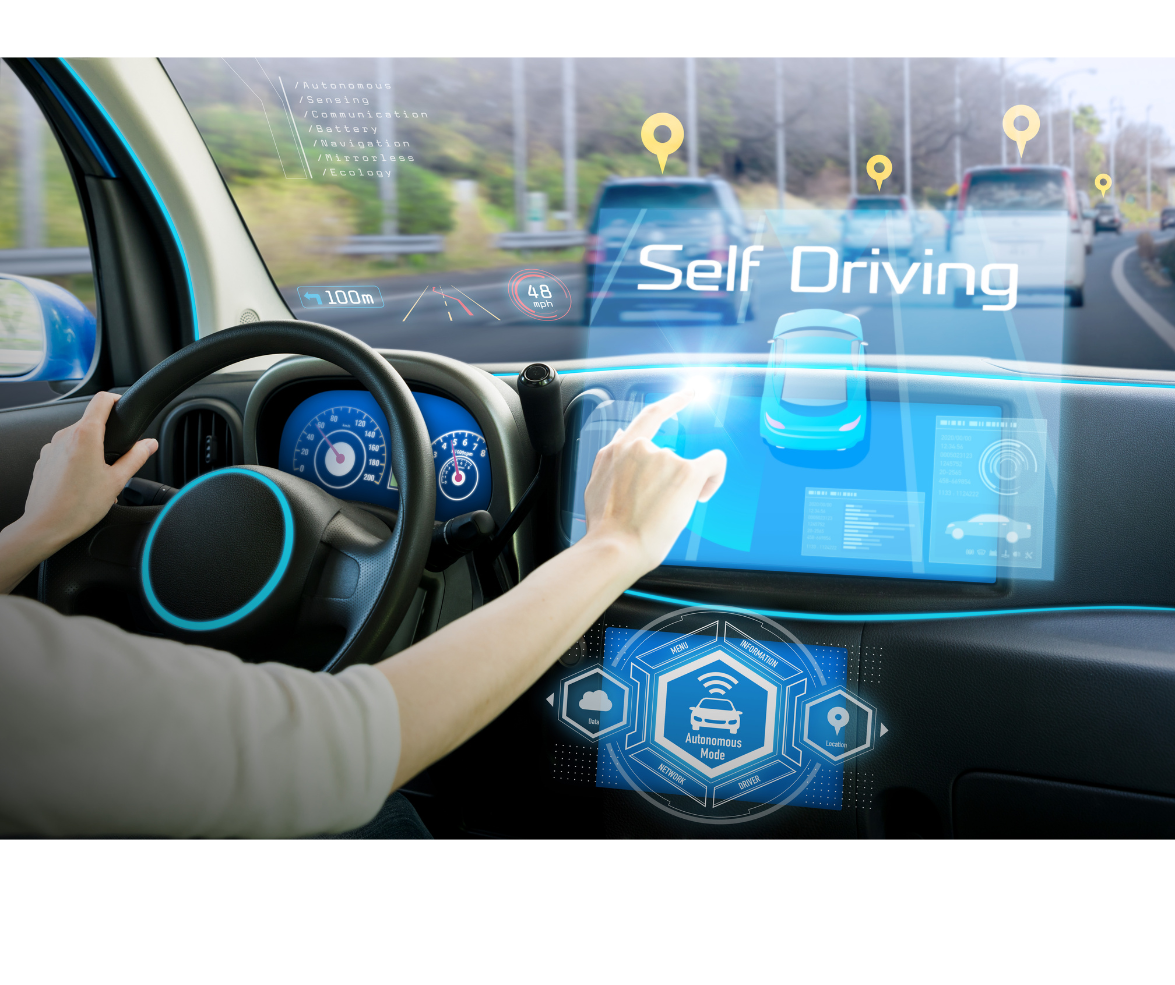
24 Feb What the Future Holds for Autonomous Automotive Design
As autonomous vehicles shift focus from driving performance to passenger experience, interior design is set to take centre stage. Here are some thoughts on what this means for automotive design, and why.
Embracing autonomy will not mean rejecting individuality. Humans are hardwired to express themselves and the car will remain a key element in that expression, whether it is self-driving or not. In this article, we will explore why car interiors will become even more important as we transition to autonomous vehicles. We will also discuss how vehicle features such as speaker grilles and interior trim are already evolving to meet growing demands for comfort, luxury and technological integration.
Levelling up
First of all, let’s define where we are on the journey to fully autonomous vehicles. The Society of Automotive Engineers (SAE) defines vehicle automation in six levels, with zero as no automation and Level 6 as the end game – full automation. In terms of mass production and day-to-day usage, we are currently at Level 2: partial driver automation. This means that the majority of new road-legal cars in Europe are equipped with some form of ADAS technology that continuously assists and intervenes with steering, braking and acceleration. However, the driver must still be in the driving seat and fully focused on driving. Beyond this, self-driving taxis and the likes of Tesla have been working on integrating more automation into their existing fleets, with some routes being trialled in San Francisco which require little to no driver interaction.
This will continue to develop as we move towards full automation across the market. With no need for a human driver, all occupants become passengers. This naturally means that their priorities also transition, with much more focus on enjoying the ride or utilising the extra time for work or entertainment. In turn, this could lead to heightened awareness of (and engagement with) the space around them, particularly the vehicle’s interior design.
For the luxurious end of the market – such as the Rolls-Royces and Bentleys of the autonomous world – it would be expected that manufacturers will continue to incorporate features that emphasise their sophistication throughout the interior. This could include more bespoke design elements, such as unique colour choices, personalised interior trim components, advanced ambient lighting systems or custom integrations like exclusive in-car entertainment systems from high-end audio system manufacturers
Market size and economic impact
Designers should be aware that this technology is evolving at a fast pace. Analysts estimate that the 2023 autonomous vehicle market size was $33.5 billion; they also forecast that the industry will grow to over $93 billion by 2028.
This could lead to a significant cultural shift in how we own and use cars. However, our desire for differentiation is unlikely to change. At Vestatec, we expect that self-driving car models will still cover the same spectrum of consumer demand, from basic functionality through to premium and, of course, luxury.
We live in an era of consumerism which encourages the aspirational pursuit of individuality and luxury. Luxury brands are defined by their look, their feel and the experiences they provide to both the consumer and onlooker. Researchers have identified several key aspects of a luxury brand, including high quality or craftsmanship, as well as offering an authentic and unique user experience. Crucially, it must also be capable of inspiring a deep connection or resonance with the consumer – meaning that luxury is also emotionally defined. With cars ultimately becoming spaces we use rather than vehicles we drive, discerning consumers are likely to expect a more luxurious offering from their vehicles. This might seem counterintuitive to what we’ve seen so far. After all, robotaxis such as the recently unveiled Tesla Cybercab and even Waymo’s driverless vehicles demonstrate a minimalist approach to interior design.
However, these vehicles are intended for mass market usage as taxis and are therefore highly cost conscious. While these companies are planning for a future where vehicles will become a service for many people, the current demographic of luxury car owners are unlikely to subscribe to this method of mobility.
These discerning consumers, who are much further up the value chain, will continue to expect a higher quality experience altogether. Our desire to express our individuality, differentiate from the mass market – and in some cases to simply show off our wealth – will continue to drive interior design in the luxury segment and beyond.
Impact on design
Within this segment, autonomous vehicles offer new design possibilities since passengers will no longer need to focus on driving, and the additional cabin space could see the introduction of interiors with tables, minibars and advanced entertainment systems becoming the norm. Naturally, there will have to be a focus on function in terms of maximising safety and optimising the location of sensors to feed accurate data into the AI control systems. However, we can also reimagine interior spaces to become more comfortable and provide features for productivity, comfort or entertainment.
While this concept of a multi-purpose space brings a lot of opportunity for creative designers, it also brings its fair share of challenges. It means that an autonomous vehicle’s interior must either be multi-functional or tailor its cabin design to meet the specific needs of individual passengers, potentially opening new market segments. For example, if the vehicle’s user is primarily looking for a space to be able to work effectively and productively while in transit, they would require a different space than a parent whose primary concern is keeping their children entertained whilst on the move.
Overall, with less emphasis on driving and more on journey experience, interiors will likely resemble modern living and working spaces. In order to differentiate, designers could be looking to focus even more on appearance, acoustics and tactile materials. Put simply, the shift to autonomous vehicles is unlikely to end the era of the car as a status symbol. There will be a huge difference between mass-produced vehicles, premium models and luxury brands. At Vestatec we expect premium interior trim to remain one of the key elements that creates this differentiation.
Continuity of current trends
What does it all mean for automotive designers? Across the sector, we expect to see growing consumer expectations for elements of customisation in luxury vehicles. The increased focus on interior design will go hand in hand with the existing, growing trend for bespoke interiors, as already offered by the likes of Bentley’s Mulliner Bespoke programme.
We also expect to see a continued shift towards “luxury accents” in premium vehicles, such as replacing plastic speaker grilles with metal. Metal components can transform functional parts into decorative features that catch the eye and are more appealing to the touch.
Metal forming and chemical etching are ideal for crafting more bespoke details, and both are already proven processes. Chemical etching allows you to create complex patterns or even holes in parts such as metal speaker grilles. Unlike conventional machining methods, it works by using chemical reactions to selectively remove areas of metal. This ensures uniform surface depth, at accuracies of up to ±0.025mm, making it the best choice for intricate interior trim elements such as a bespoke logo.
In addition, advanced metal finishing techniques such as physical vapour deposition (PVD) coating can provide another level of customisation, with a wide range of metallic colours available. These metallic colours can turn functional components within the vehicle into stylish, decorative feature pieces that stand out in even the most luxurious cabin.
Evolution, not revolution
While the adoption of autonomous vehicles is happening at a rapid pace, it is still an evolution rather than a revolution, meaning that designers can adapt accordingly. Ultimately, a Level 6 autonomous car is going to look radically different to the cars of today, but there will be step changes along the way.
Cabin aesthetics are already evolving to meet growing demands for comfort, luxury and technological integration. The autonomous vehicle of the future will transform car interiors into spaces for relaxation, work or entertainment, redefining how we engage with vehicles. This will mean more reliance on manufacturing techniques already well established by suppliers within the industry, as the car becomes more of a place for entertainment and working, but consumers still require differentiation between mass-market, premium and luxury brands.



Sorry, the comment form is closed at this time.